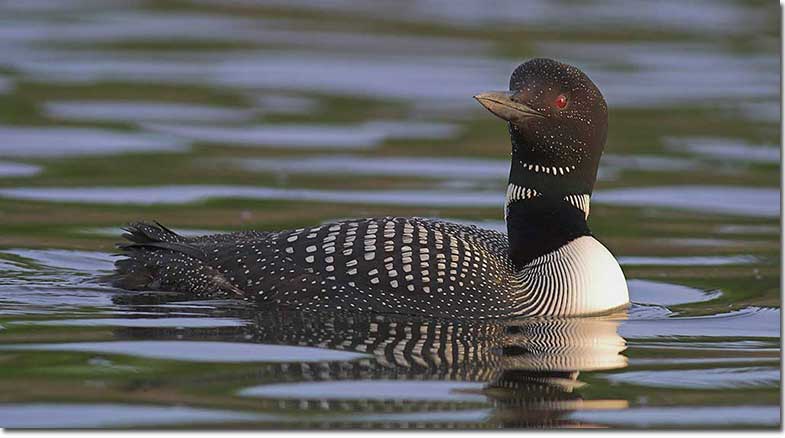The Common Loon is a large, diving waterbird. They have dagger-like bills, rounded heads, short tails that aren’t usually visible, and long bodies. When flying, these birds look elongated.
In the Summer, Common Loons inhabit North Woods lakes. They’re easy to locate during the warmer months because of how vocal they are. One Loon can yodel and induce responses from other Loons in the area.
These birds are agile, powerful divers. They’ll conduct fast underwater chases to catch small fish. It’s not common to see them on land, they usually come ashore to nest, and that’s it.
On this page
Breeding Male
In the summer months, adult Common Loons have a black bill and head, a white breast, and a black-and-white spotted back. In the winter months, Common Loons are plain gray above and white below. Their bills fade to gray as well.
Common Loons are 26.0 to 35.8 inches (66 to 91 centimeters) long and weigh 88.2 to 215.2 ounces (2500 to 6100 grams).
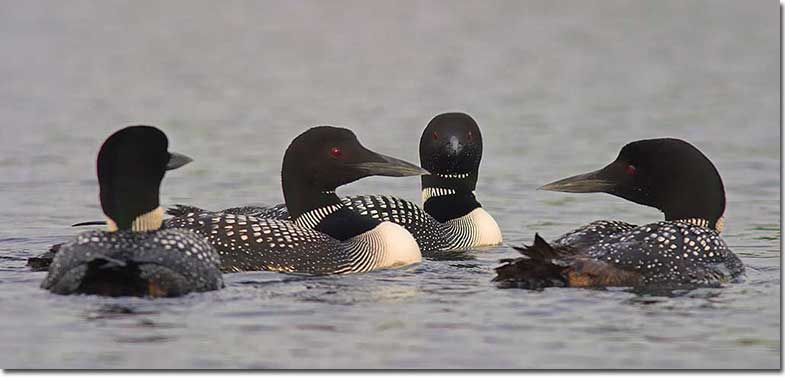
Unlike Cormorants and Ducks, Common Loons stick their feet out beyond their tail, causing them to look like wedges. These birds have shorter necks, are smaller than Canada Geese, and are longer-bodied and larger than a Mallard.
Female
Female Common Loons look identical to male Common Loons.
Juvenile
Like the females, juvenile Common Loons look identical to breeding male Common Loons, except they have more pronounced scalloping on their backs.
On average, it takes 27 days for Common Loons to hatch, and chicks hatch 12 to 24 hours apart. Juvenile Common Loons stay with their parents until around 12 weeks. Then, the parents migrate, leaving the juveniles behind to gather into flocks, where they will migrate a few weeks later.
Habitat
Common Loons inhabit North Woods lakes. These birds will choose lakes with islands and coves before any other areas because they provide cover from predators while nesting and resting. They also require a decent surface area on lakes for their flapping-and-running takeoffs.
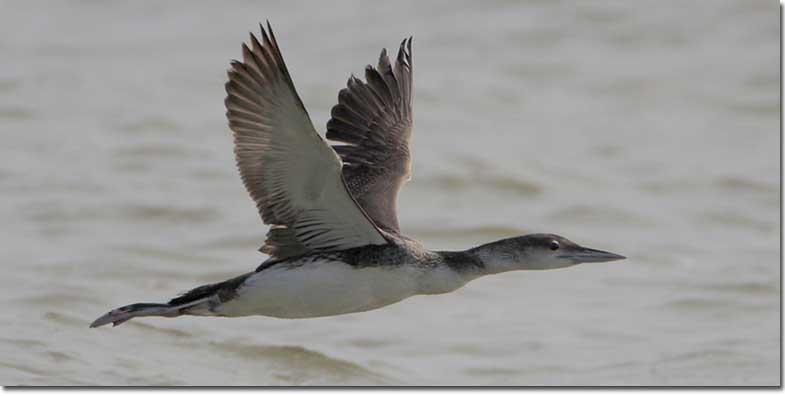
In their winter habitats, along ocean coasts, Common Loons stay pretty close to shore and in estuaries and bays. However, some Common Loons will winter inland, on slow-moving rivers and large reservoirs.
Common Loons that migrate through the middle of North America find large rivers and lakes to move from while relocating.
Diet
Common Loons mainly eat fish—especially sunfish and perch, which are abundant in their habitat. If the water is too murky for fishing or the fish are scarce, Common Loons will consume snails, aquatic insect larvae, crustaceans, and leeches.
Common Loons are excellent fishers. Their fishing methods underwater area sight to see! Loons dart through the water like a torpedo and propel themselves with their feet.
When their target changes direction, these birds are able to do a flip-turn quickly. They do this by extending one of their feet laterally to brake and kick with the other foot to turn themselves 180 degrees.
Common Loons will eat smaller fish like Atlantic croakers in their wintering grounds. These birds will sometimes work together to chase schools of Gulf silverside fish.
Behavior
Common Loons spend most of their time in shallow waters looking for fish. They’ll swim slowly, sticking their heads into the water, looking for prey.
Once they spot a fish, they’ll dive down without leaving a ripple on the surface. Common Loons only feed during the day because that’s when they can best see their prey. Loons are known to perform a territorial display involving lifting their body out of the water and flapping their wings forcefully.
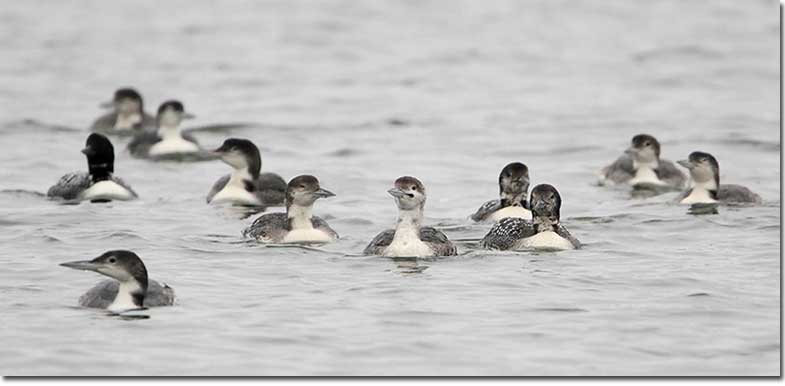
Common Loon
There is no documentation of loons harming humans; however, these birds can be aggressive toward other waterfowl during the breeding season.
Range (and seasonal changes)
Common Loons are medium-distance migrants. They migrate to coastal ocean waters from northern lakes.
Common Loons in Alaska and western Canada migrate to the west coast of North America, and Common Loons from the eastern portions of Canada migrate to the east coast of North America. Birds in the Great Lakes area migrate to Florida coasts and the Gulf of Mexico.
Wing shape
Common loons have pointed, narrow wings and a wingspan of 40.9 to 51.6 inches (104 to 131 centimeters).
Fun Facts
- Common Loons are waterfowl that only go on shore to nest and mate. Their legs sit on the back of their bodies, which allows them to be such efficient swimmers. However, their movement is awkward on land.
- Common Loons are known for their incredible speeds in the water; however, they’re fast fliers as well! Common Loons that are migrating can hit speeds of more than 70 mph.
- Most birds have hollow bones, but Loons are different. These birds have solid bones, making them better at diving and less buoyant. They can quickly flatten their feathers to discharge air in their plumage and rapidly blow air out of their lungs. This allows them to dive quickly and swim fast underwater to catch prey. Additionally, their heart rate slows once their underwater to save oxygen.
- The Common Loon is Minnesota’s state bird.
- Common Loons eat a lot of food! For example, a pair of Loons can eat as much as 425kg of fish during the breeding season!
Vocalization
Common Loons are known for their beautiful yet eerie calls. These birds yodel, tremolo, hoot, and wail. Male Common Loons are the ones that yodel. They do this to claim territory.
Each male has their own distinct yodel. If a male moves territories, he’ll change his yodel. The tremolo is a wavering call. Common Loons create this sound to announce their presence or when frightened.
Next, we have the hoot. Hoots are short, soft calls that loons use to stay in contact with one another. For example, one mate might hoot to another, or parents may hoot to their hatchlings.
Finally, the wail is the eeriest call that these birds produce. They wail when trying to figure out each other’s location.
Similar Species
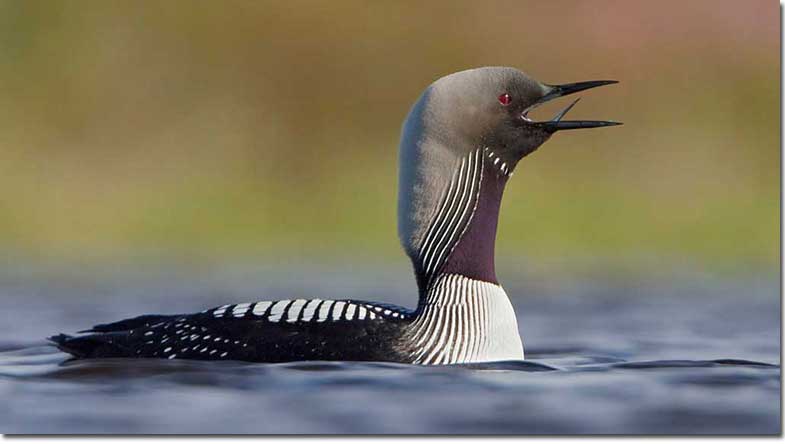
Pacific Loon
Compared to Common Loons, Pacific Loons are smaller, and their plumage looks a lot paler.
While Common Loons have more darker colors in their plumage, Pacific Loons have more gray tones, especially on their necks and heads.
Females look more similar to each other.
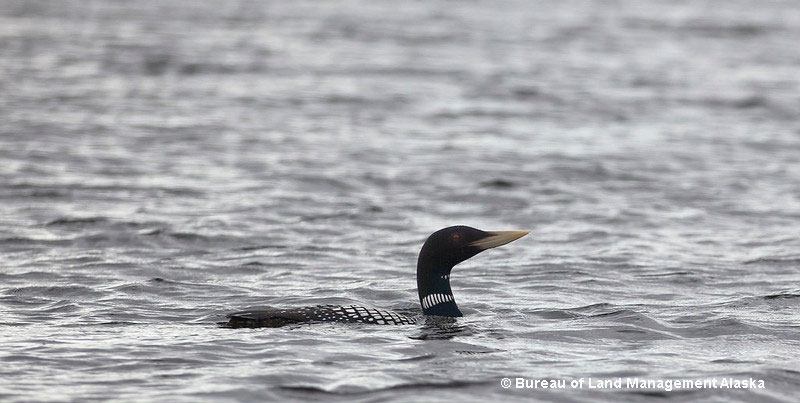
Yellow-billed Loon. Photograph © Bureau of Land Management Alaska
Yellow-billed Loon
Overall, Common Loons and Yellow-billed Loons look very similar, but as the name hints, the main difference comes in the form of their bills.
Common Loons have black bills, that are on the thinner side, while Yellow-billed Loons have yellow bills, that are slightly thicker.
Yellow-billed Loons can be spotted in arctic waters.
Frequently Asked Questions
Where are Common Loons found?
Common Loons inhabit North Woods lakes. In their winter habitats, along ocean coasts, Common Loons stay pretty close to shore and in estuaries and bays. However, some Common Loons will winter inland, on slow-moving rivers and large reservoirs.
Is a Common Loon a duck?
No, the Common Loon is not a duck. They are waterfowl.
Why can’t loons walk on land?
Loons can walk on land, but it’s awkward for them. This is because their legs are close to the back of their bodies.
Are Common Loons aggressive?
There is no documentation of loons harming humans; however, these birds can be very aggressive toward other waterfowl during the breeding season.

